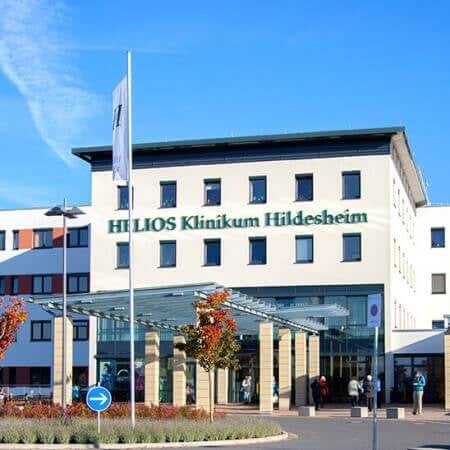Diagnostic of Lung Cancer
Treatment prices are regulated by national law of the corresponding countries, but can also include additional hospital coefficients. In order to receive the individual cost calculation, please send us the request and medical records.

Department of Pulmonology
The Department of Pulmonology offers the full range of diagnostic and therapeutic services in the area of its specialization. Of particular interest to the team of the department's doctors is the treatment of inflammatory lung diseases (bronchitis and pneumonia), chronic obstructive pulmonary disease, pulmonary emphysema and tuberculosis. In addition, the specialists of the medical facility admit patients with benign and malignant tumors of the lungs, bronchi and pleura. These patients are treated in collaboration with thoracic surgeons. With appropriate clinical indications, neoplasms can be removed during bronchoscopy – a sparing interventional procedure. In complex cases, thoracic surgeons perform open surgery. The department's pulmonologists have long clinical experience, and therefore they successfully use the very latest drugs for the treatment of pathologies of the lungs and other respiratory organs. The course of treatment for each patient is developed strictly on an individual basis.



Department of Adult and Pediatric Gastroenterology, Endocrinology, Infectology, Nephrology, Cardiology and Pulmonology
The Department of Adult and Pediatric Gastroenterology, Endocrinology, Infectology, Nephrology, Cardiology and Pulmonology offers the full range of diagnostic and therapeutic services in these medical specialties. The healthcare facility admits patients of all age groups. Many diagnostic and therapeutic procedures are performed on an outpatient basis. The department's team of doctors specializes in the treatment of diseases of the gastrointestinal tract, diabetes mellitus, infectious diseases, and pathologies of the kidneys, heart, and respiratory system. The department has modern diagnostic rooms fitted out with equipment for ultrasound, X-ray, electrocardiography, echocardiography, and endoscopic examinations. During treatment, individually developed drug therapy regimens are most often used. Patients with end-stage renal insufficiency are offered renal replacement therapy (dialysis). For this purpose, there is a dialysis unit with 10 beds. The department's nephrology team also provides preparation and follow-up care after a kidney transplant. The department's doctors strictly adhere to current clinical protocols and are always open to personal communication with the patient, trying to best satisfy their individual needs and wishes.





Department of Pulmonology
The Department of Pulmonology provides the full range of diagnostic tests and therapeutic procedures for patients with diseases of the respiratory tract and lungs. The department's clinical practice focuses on the treatment of bronchial asthma, chronic obstructive pulmonary disease, interstitial lung disease, pneumonia, lung and pleural tumors, as well as breathing disorders and respiratory failure. In addition, the department is distinguished by its particular competence in the field of weaning. The critically ill patients are provided with high-quality resuscitation procedures within the specialized Intensive Care Unit. The department's specialists successfully perform invasive and non-invasive mechanical ventilation. The Sleep Laboratory serves for the comprehensive assessment of a patient's sleep quality and treatment of sleep-related breathing disorders. Each patient receives an individualized treatment regimen based on his medical history, particular clinical indications and general state of health. Such an approach guarantees the most favorable treatment outcome.




Lung cancer remains one of the most unfavorable oncological diseases. It mainly affects smokers. Most patients die within the first year after diagnosis. In developed countries, the doctors use diagnostic techniques, which allow them to detect the disease at an early stage. The high-quality clarifying diagnostics helps to better plan treatment and achieve good results.
Is it possible to diagnose lung cancer at the initial stages?
Lung cancer is the most commonly diagnosed cancer in the world. It is in the first place in the number of deaths from cancer causes. Therefore, many developed countries try to organize a screening of this pathology. The outstanding successes in this field have not yet been achieved, but some methods, which contribute to the early detection of malignant lung tumors in individual patients are already available. At the same time, the screening for the whole population is still not carried out.
Previously, the doctors tried to use a chest X-ray for early diagnostics, but it turned out that this screening method is not very effective. It does not significantly affect patient survival. Those tumors, which are detected on X-rays, in most cases are too large to be cured.
In recent years, low-dose CT scans have been used for the examination of people at risk group for lung cancer in developed countries. It helps to detect small neoplasms in the lungs, which may be malignant. Such examination should be carried out once a year. It reduces the risk of death from lung cancer.
Indications for the preventive annual examination:
- Smoking or quitting less than 15 years ago
- Age after 55 years
In combination of these two factors, the patient should be examined. It should be understood that even CT scan does not guarantee success in the cancer treatment, because some small tumors will not be detected. In other patients, CT scan reveals cancer too late, so it cannot be cured.
In the following cases lung cancer screening is not recommended:
- The presence in the body of metal devices, which interfere with CT scans, these are usually pacemakers or mechanical rods in the spine
- Concomitant somatic diseases, which are a contraindication to surgical treatment
- Age above 75 years
The examinations carried out in the United States on 50,000 people showed the effectiveness of screening using CT scanning. It turned out that smokers who underwent such a preventive examination for 3 years were 20% less likely to die from lung cancer than those who had a chest X-ray. They also had 7% lower risk of death from all causes.
Nevertheless, the screening has drawbacks. In 25% of people in the above mentioned examination, the detected neoplasm was not cancer. Therefore, they underwent a procedure, which was not necessary for them. This is usually CT scan, tumor biopsy or removal of a part of the lung.
Symptoms
Most cases of lung cancer are detected only after the onset of clinical signs, but when the symptoms occur, it means that the tumor has already reached a large size. The exception is central cancer. It affects the large bronchus. If the neoplasm grows in the direction of its lumen, then symptoms may appear earlier.
The disease has the following signs:
- Dry cough
- Hemoptysis
- Chest pain, which worsens at the height of inspiration or in coughing
- Weight loss
- Irregular breathing
- Frequent infections, recurrent pneumonia
- Weakness, fatigue, loss of appetite, weight loss
Lung cancer can spread metastases. In this case, symptoms occur from other organs. This can be bone pain, jaundice, enlarged supraclavicular lymph nodes, headache.
Lung cancer has the following specific symptoms:
Horner's syndrome or oculosympathetic syndrome occurs in cancer of the apex of the lung. Due to nerve compression in a person, sweat does not cover one side of the face, the pupil narrows on the same side, the eyelid drops. In apex cancer, the shoulder often hurts.
Superior vena cava syndrome occurs near the lung. In the case of compression by a tumor, the face, hands and upper part of the thorax swell. The cyanosis of the skin in these areas is also possible. Many patients complain about headache and dizziness.
Paraneoplastic syndromes may cause the first symptoms in some types of lung cancer. Even if metastases are absent, the signs of the disease occur from other organs and systems due to hormonal imbalance, increased levels of calcium in the blood, a tendency to thrombosis and damage to the nervous system.
Establishment and clarification of the diagnosis
When the diagnostics is required:
- Onset of lung cancer symptoms
- Detection of pathological changes in lung tissue on X-ray or low-dose CT scan
Should a suspicious lesion be detected, the standard CT scan will be prescribed. It is characterized by a higher dose of radiation and the need for injection of intravenous contrast agent, but shows more accurate results.
The diagnosis can be confirmed by cytological or histological examination, which is obtained from the lung material. The doctors can obtain it using many techniques:
- Sputum is collected for three days in a row in the morning and mainly helps to detect squamous cell carcinoma
- Pleurocentesis – pleural puncture for the obtaining of pleural fluid, it is performed in case of effusion, the fluid can be sent for cytological examination
- Fine needle biopsy – a needle can be inserted through the esophagus, trachea or thoracic skin
- Bronchoscopy – the insertion of a tube into the bronchus allows the doctor to obtain a sample of the tumor, if it is in the reach of the endoscope
Clarifying methods:
- CT scan allows the doctor to detect metastases, enlarged lymph nodes
- MRI is carried out for the detection of metastatic foci in the central nervous system
- PET – a radiopharmaceutical is injected into the body, which "highlights" metastatic foci during follow-up scanning. It does not provide accurate imaging, but indicates the location of metastases in any part of the body
- X-ray examination of bones for the detection of bone metastases
- Endobronchial and transesophageal ultrasound scanning, with the placement of a sensor inside the bronchi or esophagus, it can reveal enlarged lymph nodes
- Mediastinoscopy is an invasive diagnostic method, during which the doctor can assess the condition of the lymph nodes near the trachea and large bronchi
- Thoracoscopy is a diagnostic operation involving the insertion of a thin tube with a camera into the thorax through a small incision
Diagnostics abroad with the Booking Health company
You can undergo the diagnostics and treatment of lung cancer abroad, in one of the best hospitals in the world. To do this, you can book the program via the Booking Health service. The doctors abroad perform effective operations, which can preserve lung function. To improve the effectiveness of surgical treatment, intraoperative chemotherapy, irradiation, immunotherapy and other techniques can be used. When booking a diagnostic and treatment program via Booking Health, you will receive the following benefits:
- Selection of the best clinic, which specializes in the treatment of lung cancer, uses the very latest techniques, shows good statistics.
- Reduced costs for medical services up to 50% due to the lack of overpricing and additional coefficients for foreign patients.
- Booking an appointment on the most suitable dates for you.
- Preparation of the program, taking into account previously performed tests.
- Establishment of communication directly with the attending physician.
- Monitoring of the diagnostic or therapy program all its stages.
- Control of invoices, return of unspent funds.
- Buying and forwarding of medicines.
- Organization of additional diagnostic or therapeutic procedures.
- Communication with the hospital upon the diagnostics and therapy completion.
The Booking Health company will provide you with top-class services. We will book a hotel and airline tickets for you, arrange a transfer from the airport to the hospital and back.

